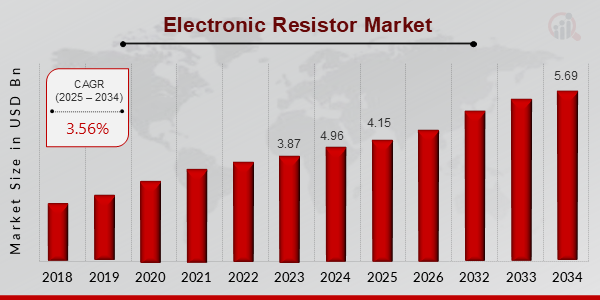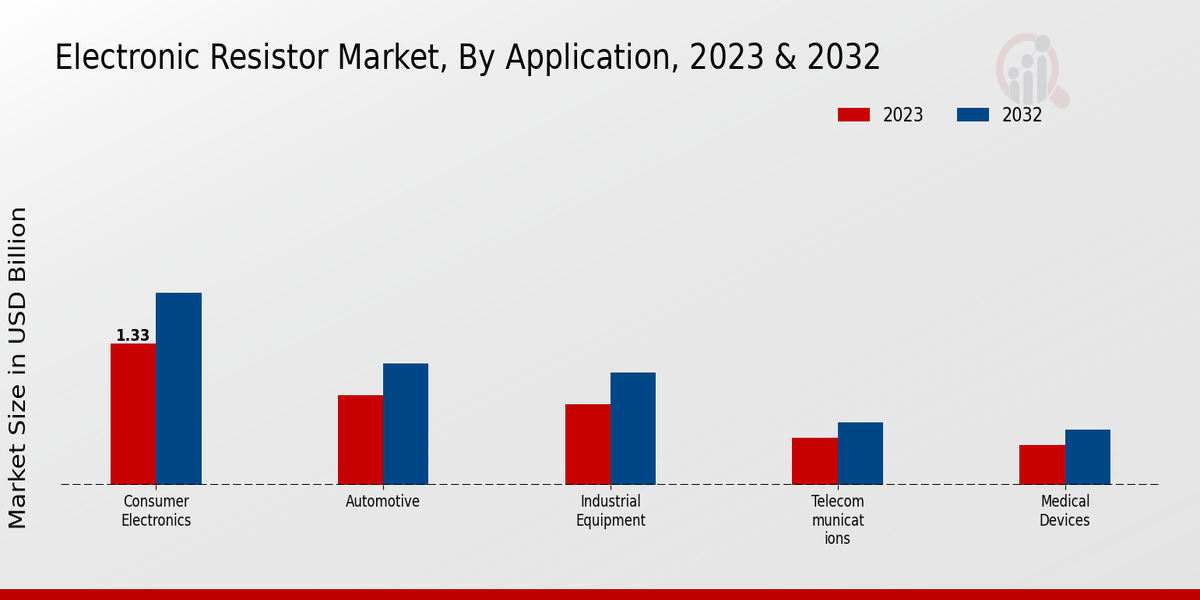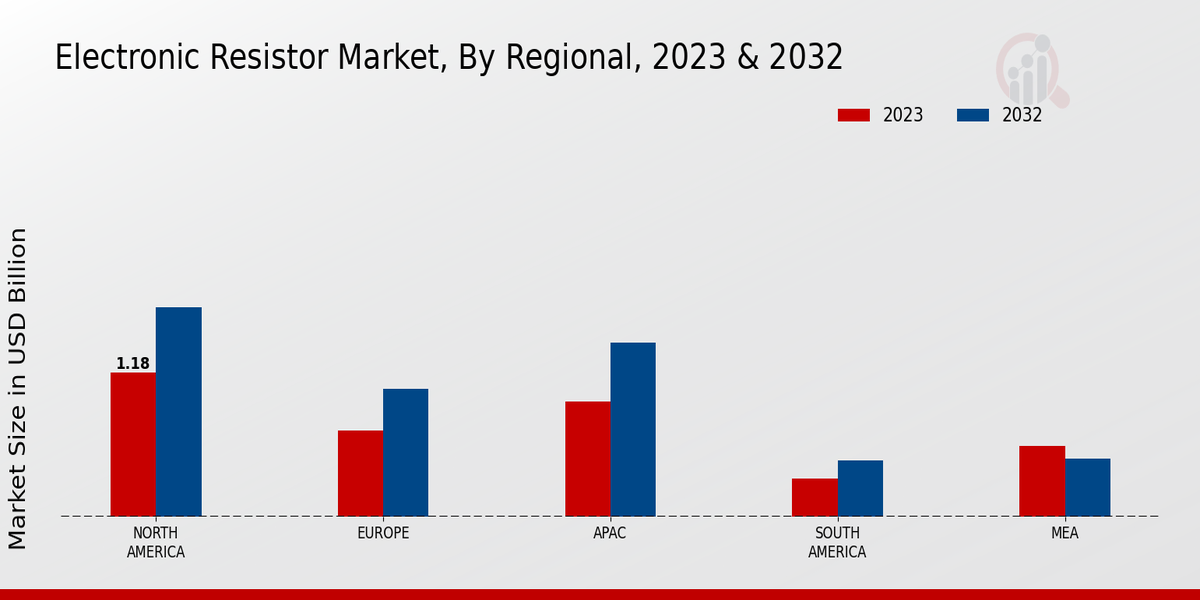Electronic Resistor Market Overview
Electronic Resistor Market is projected to grow from USD 4.15 Billion in 2025 to USD 5.69 Billion by 2034, exhibiting a compound annual growth rate (CAGR) of 3.56% during the forecast period (2025 - 2034). Additionally, the market size for Electronic Resistor Market was valued at USD 4.96 billion in 2024.
Key Electronic Resistor Market Trends Highlighted
The Electronic Resistor Market is experiencing notable growth driven by the increasing demand for various electronic devices across multiple sectors. The rise of consumer electronics, electric vehicles, and renewable energy systems is propelling the need for resistors that can ensure reliable performance and energy efficiency. The growing trend towards miniaturization of electronic components has also heightened the importance of compact resistors. Moreover, the shift towards smart technologies and the Internet of Things (IoT) presents significant opportunities for innovative resistor designs that cater to advanced applications, emphasizing the importance of adaptability in resistor technology.
In recent times, there has been a noticeable focus on developing resistors that enhance energy efficiency and sustainability. This trend reflects the broader industry shift towards reducing carbon footprints and promoting eco-friendly electronic solutions. Additionally, advancements in materials science are driving the production of resistors that offer better thermal performance and endurance under extreme conditions. The combination of higher performance and energy efficiency is appealing to manufacturers, leading to increased investments in research and development. Opportunities in the Electronic Resistor Market are also expanding as industries seek specialized resistors to meet unique requirements.
For instance, the automotive and aerospace sectors require precision resistors that can withstand harsh environments. Furthermore, emerging markets are witnessing a surge in electronic manufacturing, creating a new customer base for resistor suppliers. As the market evolves, partnerships between component manufacturers and technology firms are likely to foster innovation and lead to the creation of next-generation resistors that can meet the demands of increasingly complex electronic systems. This dynamic landscape underscores the vital role that resistors will play in shaping the future of electronics, making it essential for stakeholders to stay aligned with these market trends.
Fig 1: Electronic Resistor Market Overview

Source: Primary Research, Secondary Research, MRFR Database and Analyst Review
Electronic Resistor Market Drivers
Growing Demand for Electronic Devices
The increasing proliferation of electronic devices across various sectors is a major driver for the Electronic Resistor Market Industry. As the demand for consumer electronics such as smartphones, tablets, laptops, and smart home devices continues to surge, the need for advanced electronic components, including resistors, becomes critical. Furthermore, the trend toward smart technologies, IoT (Internet of Things) applications, and automation has fueled the development of sophisticated electronic circuits that require reliable resistor solutions.
This escalating requirement for high-performance resistors in consumer and industrial applications translates into the consistent growth of the Electronic Resistor Market as manufacturers strive to meet the evolving demands of technology-driven consumers. Additionally, sectors such as automotive, telecommunications, healthcare devices, and renewable energy systems are progressively adopting advanced electronic solutions, leading to a more extensive utilization of resistors.
As new electronic products integrate more complex functionalities, the necessity for a variety of resistor types, including surface mount resistors, precision resistors, and high-power resistors, increases exponentially. Thus, the overall expansion of the electronic devices market directly correlates with the growth potential of the Electronic Resistor Market, allowing manufacturers and suppliers to innovate, curb and cater to diverse applications across industries.
Technological Advancements in Resistor Manufacturing
Technological progress in the manufacturing processes of electronic resistors plays a significant role in the growth of the Electronic Resistor Market Industry. Innovations in materials science, production techniques, and automated machinery have enhanced the efficiency and precision of resistor manufacturing. This has resulted in higher quality products that can withstand extreme conditions and provide better performance. Improved fabrication processes also allow for miniaturization, enabling the creation of smaller and more efficient electronic components. As manufacturers adopt advanced technologies such as 3D printing and nanotechnology, the variety and application range of resistors expand, addressing customer needs across different sectors and thus enhancing market growth.
Increasing Environmental Awareness and Energy Efficiency
The rising emphasis on energy efficiency and environmental consciousness drives the Electronic Resistor Market Industry. Consumers and manufacturers alike are increasingly prioritizing sustainable electronic practices, leading to the development of energy-saving and eco-friendly products. Resistors play a crucial role in optimizing the performance of electronic devices while minimizing energy waste. This trend toward sustainable designs not only promotes the use of energy-efficient resistors but also compels manufacturers to innovate and create products that align with green initiatives, thereby contributing to market expansion and growth.
Electronic Resistor Market Segment Insights
Electronic Resistor Market Application Insights
The Electronic Resistor Market revenue showcases significant growth across various applications, with the complete market valued at 3.74 USD Billion in 2023 and projected to reach 5.12 USD Billion by 2032. Notably, the Consumer Electronics application commands a major share, valued at 1.33 USD Billion in 2023 and expected to grow to 1.81 USD Billion by 2032, reflecting the continuous demand for electronic devices such as smartphones, televisions, and computers. This segment is crucial as it not only drives the majority of the market but also influences technological advancements and product innovations within the industry.
The Automotive sector, valued at 0.84 USD Billion in 2023 and projected to grow to 1.14 USD Billion by 2032, contributes significantly to the market as vehicles become increasingly reliant on electronic components, emphasizing the need for robust electronic resistors in advanced automotive systems, including electric and autonomous vehicles. In the Industrial Equipment domain, with a valuation of 0.76 USD Billion in 2023 and anticipated to rise to 1.06 USD Billion in 2032, there is a growing trend towards automation and smart manufacturing processes, where electronic resistors play a pivotal role in ensuring the reliability and performance of machinery.
Telecommunications also represents a vital application, valued at 0.44 USD Billion in 2023 and expected to reach 0.59 USD Billion by 2032, as the demand for high-speed internet and mobile communications increases, driving the need for efficient electronic resistors in networking equipment and communication devices. Lastly, the Medical Devices application, valued at 0.37 USD Billion in 2023 and projected to increase to 0.52 USD Billion by 2032, plays a significant role in the market, given the rising utilization of electronic components in medical technology, thus underscoring the importance of precise and reliable resistors for diagnostic and monitoring equipment. Collectively, these applications highlight the diverse landscapes of the Electronic Resistor Market, revealing a multifaceted industry where growth is propelled by technological advancements and evolving consumer needs, with varying degrees of dominance based on application demands and market trends.
Fig 2: Electronic Resistor Market Insights

Source: Primary Research, Secondary Research, MRFR Database and Analyst Review
Electronic Resistor Market Type Insights
The market comprises Fixed Resistors, Variable Resistors and Specialty Resistors, each serving a distinct purpose. Fixed Resistors hold a majority share in this market due to their widespread use in electronic circuits, providing constant resistance. Variable Resistors, while accounting for a significant portion, offer adaptability in applications where resistance needs to be adjusted, making them crucial for devices like volume controls. Specialty Resistors, though a smaller segment, are important for high-performance applications such as automotive and aerospace, where precision is vital. Overall, the market growth is driven by advancements in technology and increasing demand for electronic devices, although challenges like component miniaturization and cost pressures remain. The Electronic Resistor Market statistics indicate a steady demand across all Types, reflecting the critical role these components play in the evolving electronic landscape.
Electronic Resistor Market Material Insights
The Electronic Resistor Market, particularly within the Material segment, is poised for notable growth. Carbon Film, Metal Film, Wire-wound, Thick Film and Thin Film are significant components of this segment, each fulfilling unique roles in electronic designs. Carbon Film resistors are popular for their reliability and stability, while Metal Film resistors are favored for their precision and low noise characteristics.Wire-wound resistors continue to dominate due to their ability to handle high power loads, making them essential in various industrial applications. The market showcases a diversity of applications across consumer electronics, automotive, and telecommunications, driven by the ongoing push for technological advancements.
Additionally, market growth is supported by the rising adoption of smart devices, necessitating high-performance resistors. However, it also faces challenges such as supply chain disruptions and fluctuating raw material prices. Overall, as the industry moves towards a more energy-efficient future, opportunities will emerge for innovations within these materials, shaping the Electronic Resistor Market landscape for years to come.
Electronic Resistor Market Power Rating Insights
This segment is significant as it determines the power handling capacity of resistors, influencing their application in various electronic devices. The market is categorized into Low Power, Medium Power and High Power, each essential for different electronics. Power resistors are commonly used in consumer electronics, making them a substantial portion of the market. Medium Power resistors serve in industrial applications, striking a balance between capacity and efficiency.
Power resistors are critical in high-performance applications, often dominating the market due to their ability to handle greater energy loads. The growth of the Electronic Resistor Market can be attributed to the increasing demand for electronics in diverse sectors, driving the need for reliable resistors across all power ratings. Factors such as technological advancements and the growth of renewable energy sectors present opportunities within the market. However, challenges persist, including the fluctuation in raw material prices affecting production costs. Overall, trends show a consistent evolution and adaptation within the Power Rating segment of the Electronic Resistor Market.
Electronic Resistor Market Regional Insights
The Electronic Resistor Market is projected to generate significant revenue across various regions, reflecting a diverse landscape. In 2023, North America led with a valuation of 1.184 USD Billion, dominating the market due to its advanced electronics sector and high demand for resistors in various applications. Europe follows closely behind, valued at 0.71 USD Billion, benefiting from a strong automotive and industrial manufacturing industry that drives the need for high-quality electronic components. The APAC region, valued at 0.947 USD Billion, is also noteworthy, as it encompasses major electronics manufacturers and demonstrates rapid growth fueled by increased production capabilities and consumer electronics demand.
South America, with a valuation of 0.316 USD Billion, and MEA, at 0.584 USD Billion, are smaller but evolving markets, highlighting the regional diversity in the Electronic Resistor Market segmentation. The challenges in these regions include infrastructure limitations and varying technology adoption rates, yet opportunities for growth remain, particularly in emerging economies adopting electronic technologies. Overall, the variance in regional market valuations reflects differing industrial needs and influences the overall trajectory of the Electronic Resistor Market industry, providing insight into both competitive advantages and areas for development.
Fig 3: Electronic Resistor Market Regional Insights

Source: Primary Research, Secondary Research, MRFR Database and Analyst Review
Electronic Resistor Market Key Players and Competitive Insights
The Electronic Resistor Market is characterized by a dynamic competitive landscape driven by continuous technological advancements, diverse applications, and increasing demand across various industries. Given the proliferation of electronic devices and systems, the need for precise resistive components has soared, resulting in an influx of both established companies and emerging players vying for market share. Key drivers of competition include product innovation, the introduction of new materials, cost efficiency, and a focus on sustainability to meet evolving regulatory standards. Market participants are increasingly focusing on expanding their geographical footprint, enhancing distribution channels, and leveraging strategic partnerships to capitalize on the growing demand for high-performance resistors in sectors such as automotive, telecommunications, and consumer electronics.
Vishay Intertechnology is recognized as a formidable player in the Electronic Resistor Market, benefiting from its extensive range of high-quality resistor products tailored for various applications. The company's commitment to innovation is underscored by its continuous investment in research and development, allowing it to introduce state-of-the-art resistors that meet contemporary market demands. With a broad product portfolio that includes thin film, thick film, and wire-wound resistors, Vishay Intertechnology caters to a diverse clientele, ensuring compatibility with modern electronic designs. The company's strong presence in markets, combined with its ability to deliver customized solutions, positions it favorably against competitors, enhancing customer loyalty and satisfaction.Bourns has established itself as a key player in the Electronic Resistor Market by offering an extensive selection of resistive components recognized for their reliability and performance.
The company has capitalized on its engineering expertise to design innovative resistors suitable for a myriad of applications, ensuring they meet various specifications and standards. Bourns focuses heavily on quality control and sustainability practices in the production of its resistors, resonating well with environmentally conscious consumers and manufacturers. With a distribution network and a commitment to excellent customer service, Bourns effectively addresses the needs of its clients, allowing it to maintain a prominent position in the competitive landscape of electronic resistors while consistently adapting to market challenges and opportunities.
Key Companies in the Electronic Resistor Market Include
Electronic Resistor Market Industry Developments
Recent developments in the Electronic Resistor Market have witnessed various advancements and strategic movements among key players. Vishay Intertechnology has introduced new high-performance resistors aimed at enhancing power efficiency in electronic devices. Bourns is actively expanding its product line, emphasizing innovative solutions for automotive applications, reflecting the market's growing demand for specialized resistors. Companies like Ohmcraft and Amphenol are also focusing on high-precision resistors to cater to the aerospace and military sectors.
Additionally, Fenghua Advanced Technology and Kemet Corporation have been increasing production capacities to meet the rising needs in consumer electronics. ROHM Semiconductor and TT Electronics are investing in R&D to develop smart resistive components capable of integrating with IoT devices. Notably, merger and acquisition activities among these firms have strengthened market positions; for example, NXP Semiconductors' acquisition of a smaller tech firm has bolstered its capabilities in automotive electronics. Te Connectivity and Panasonic Corporation are also exploring partnerships to expand their market presence. The valuation of these companies is experiencing growth due to heightened demand for electronic components, particularly in the context of the increasing reliance on automation and smart technologies across various industries, fostering a significant impact on the overall market landscape.
Electronic Resistor Market Segmentation Insights
Electronic Resistor Market Application Outlook
- Consumer Electronics
- Automotive
- Industrial Equipment
- Telecommunications
- Medical Devices
Electronic Resistor Market Type Outlook
- Fixed Resistors
- Variable Resistors
- Specialty Resistors
Electronic Resistor Market Material Outlook
- Carbon Film
- Metal Film
- Wirewound
- Thick Film
- Thin Film
Electronic Resistor Market Power Rating Outlook
- Low Power
- Medium Power
- High Power
Electronic Resistor Market Regional Outlook
- North America
- Europe
- South America
- Asia Pacific
- Middle East and Africa
|
Report Attribute/Metric
|
Details
|
|
Market Size 2024
|
4.96 (USD Billion)
|
|
Market Size 2025
|
4.15 (USD Billion)
|
|
Market Size 2034
|
5.69 (USD Billion)
|
|
Compound Annual Growth Rate (CAGR)
|
3.56% (2025 - 2034)
|
|
Report Coverage
|
Revenue Forecast, Competitive Landscape, Growth Factors, and Trends
|
|
Base Year
|
2024
|
|
Market Forecast Period
|
2025 - 2034
|
|
Historical Data
|
2019 - 2023
|
|
Market Forecast Units
|
USD Billion
|
| Key Companies Profiled |
Vishay Intertechnology, Bourns, Ohmcraft, Amphenol, Fenghua Advanced Technology, Kemet Corporation, ROHM Semiconductor, TT Electronics, AVX Corporation, Murata Manufacturing, Yageo Corporation, Wohmtech, NXP Semiconductors, TE Connectivity, Panasonic Corporation |
| Segments Covered |
Application, Type, Material, Power Rating, Regional |
| Key Market Opportunities |
Rising demand for electronic devices, Growth in automotive electronics, Increase in renewable energy solutions, Advancements in resistor technologies, Expanding telecommunications infrastructure |
| Key Market Dynamics |
Rising demand for electronic devices, Technological advancements in resistors, Increasing automotive electronics usage, Growth in the renewable energy sector, Miniaturization of electronic components |
| Countries Covered |
North America, Europe, APAC, South America, MEA |
Frequently Asked Questions (FAQ) :
The Electronic Resistor Market was expected to be valued at 3.87 USD Billion in 2023.
The projected market size for the Electronic Resistor Market by 2034 is 5.69 USD Billion.
The expected CAGR for the Electronic Resistor Market from 2025 to 2034 is 3.56%.
North America is anticipated to have the largest market size for the Electronic Resistor Market in 2023, valued at 1.184 USD Billion.
The estimated market value for the Automotive application segment in 2032 is 1.14 USD Billion.
Vishay Intertechnology is one of the major players in the Electronic Resistor Market.
The projected market value of the Industrial Equipment application in 2023 is 0.76 USD Billion.
The estimated market size for the APAC region by 2032 is 1.422 USD Billion.
The expected market value for the Consumer Electronics application segment in 2032 is 1.81 USD Billion.
The Electronic Resistor Market faces challenges from rapidly changing technologies but is driven by increasing demand for consumer electronics.

















